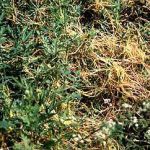| Common Name: |
Japanese Dodder |
| Botanical Name: |
Cuscuta japonica syn. C. systyla |
| Genus: |
Cuscuta |
| Family: |
Convulvulaceae |
| Native Location: |
E Asia |
| Cultivation: |
Grows only on suitable host plants. Some species are subject to certain plant controls in parts of Australia. |
| Propagation: |
By seed in autumn, lodged among stems of host plant. |
| Harvest: |
Seeds are collected when ripe in autumn. They are then dried for use in decoctions. |
| Height: |
1m (3ft) |
| Width: |
1m (3ft) |
| Hardiness: |
Hardy |
| Parts Used: |
Seeds (tu si zi) |
| Properties: |
A sweet, pungent herb that acts mainly as a kidney and liver stimulant. |
| Medicinal Uses: |
Internally for diarrhea, impotence, urinary frequency, vaginal discharge, and poor eyesight associated with liver and kidney energy weakness. |
| Bibliography: |
Encyclopedia of herbs by Deni Brown Copyright © 1995, 2001 Dorling Kindersley Limited. pg 187 |

